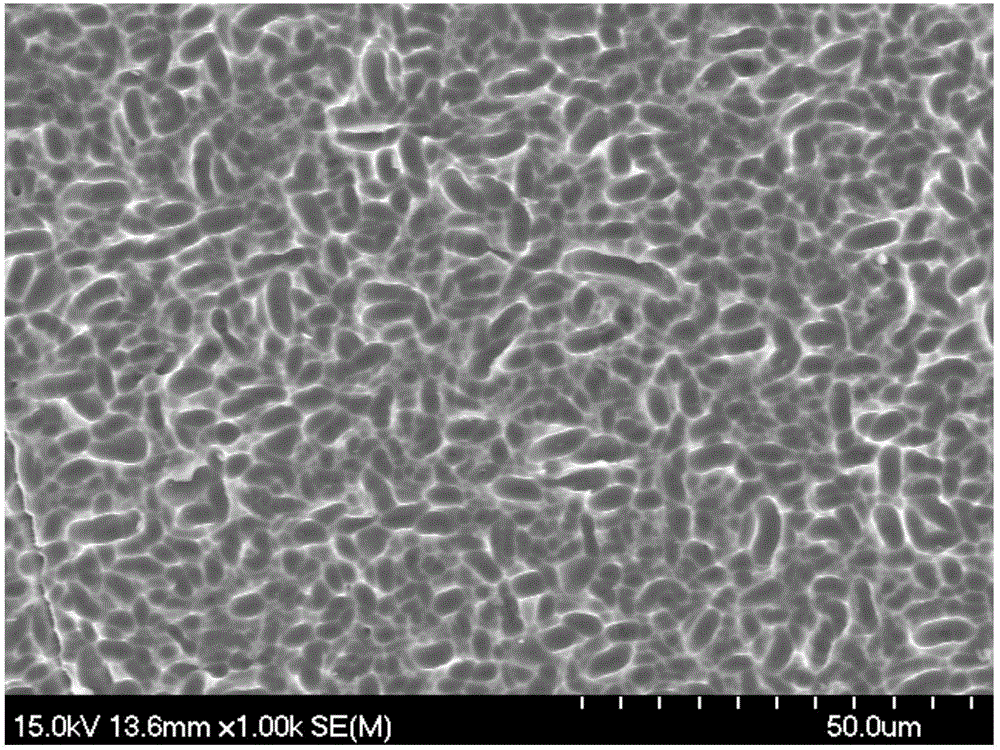Additive for polycrystalline silicon wafer texturization and application method thereof
A polycrystalline silicon wafer and additive technology, applied in the field of solar cells, can solve the problems of difficult removal, decreased conversion efficiency, metal pollution, etc., and achieve the effects of improving the texturing effect and stably increasing the conversion efficiency.
- Summary
- Abstract
- Description
- Claims
- Application Information
AI Technical Summary
Problems solved by technology
Method used
Image
Examples
Embodiment 1
[0027] comparison group
[0028] The current conventional acid cashmere method:
[0029] Prepare acid texturing solution: Add 1.25L of hydrofluoric acid with a concentration of 55%, 5.5L of nitric acid with a concentration of 65-68%, and 3.25L of deionized water into the texturing tank and stir to obtain 10L of acid texturing liquid;
[0030] Acid texturing: put the solar polysilicon wafer into the texturing tank for texturing, the texturing temperature is 7°C, and the texturing time is 90s.
[0031] The reflectance after conventional texturing is 27%.
Embodiment 2
[0033] The additive used in polycrystalline silicon chip texturing and the method for applying the additive to acid texturing adopt the following process steps:
[0034] Configure acid texturing additive: add 10g polyacrylic acid (Mw:3000-5000), 20g succinic acid, 0.5g fatty acid methyl ester ethoxylate (FMEE) into 1000ml deionized water to make polycrystalline texturing additive;
[0035] Prepare acid texturing solution: Add 1.25L of hydrofluoric acid with a concentration of 55%, 5.5L of nitric acid with a concentration of 65-68%, and 3.25L of deionized water into the texturing tank and stir to obtain 10L of acid texturing liquid;
[0036] Add 0.1L of additives to the acid texturing solution prepared in step 2);
[0037] Acid texturing: put the solar polysilicon wafer into the texturing tank for texturing, the texturing temperature is 7°C, and the texturing time is 90s.
[0038] Simultaneously by the method for embodiment 1, make conventional without adding additive of the ...
Embodiment 3
[0045] Applying the additive used for polysilicon chip texturing The method of applying the additive to acid texturing takes the following process steps:
[0046] Configure acid texturing additive: add 10g polyacrylic acid (Mw:3000-5000), 50g oxalic acid, 0.5g fatty acid methyl ester ethoxylate (FMEE) into 1000ml deionized water to make polycrystalline texturing additive;
[0047] Prepare acid texturing solution: Add 1.25L of hydrofluoric acid with a concentration of 55%, 5.5L of nitric acid with a concentration of 65-68%, and 3.25L of deionized water into the texturing tank and stir to obtain 10L of acid texturing liquid;
[0048] Add 0.1L of additives to the acid texturing solution prepared in step 2);
[0049] Acid texturing: put the solar polysilicon wafer into the texturing tank for texturing, the texturing temperature is 7°C, and the texturing time is 90s.
[0050] Simultaneously by the method for embodiment 1, make conventional without adding additive of the present i...
PUM
| Property | Measurement | Unit |
|---|---|---|
| degree of polymerization | aaaaa | aaaaa |
| reflectance | aaaaa | aaaaa |
| reflectance | aaaaa | aaaaa |
Abstract
Description
Claims
Application Information
 Login to View More
Login to View More - R&D
- Intellectual Property
- Life Sciences
- Materials
- Tech Scout
- Unparalleled Data Quality
- Higher Quality Content
- 60% Fewer Hallucinations
Browse by: Latest US Patents, China's latest patents, Technical Efficacy Thesaurus, Application Domain, Technology Topic, Popular Technical Reports.
© 2025 PatSnap. All rights reserved.Legal|Privacy policy|Modern Slavery Act Transparency Statement|Sitemap|About US| Contact US: help@patsnap.com



